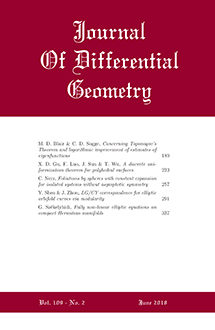Abstract
Let $(M,g, k)$ be an initial data set for the Einstein equations of general relativity.
We prove that there exist solutions of the Plateau problem for marginally outer trapped surfaces (MOTSs) that are stable in the sense of MOTSs. This answers a question of G. Galloway and N. O’Murchadha raised in “Some remarks on the size of bodies and black holes,” [Classical Quantum Gravity 25 (2008), no. 10, 105009, 9. MR 2416045] and is an ingredient in the proof of the spacetime positive mass theorem given by L.-H. Huang, D. Lee, R. Schoen, and the first named author.
We show that a canonical solution of the Jang equation exists in the complement of the union of all weakly future outer trapped regions in the initial data set with respect to a given end, provided that this complement contains no weakly past outer trapped regions. The graph of this solution relates the area of the horizon to the global geometry of the initial data set in a non-trivial way. We prove the existence of a Scherk-type solution of the Jang equation outside the union of all weakly future or past outer trapped regions in the initial data set. This result is a natural exterior analogue for the Jang equation of the classical Jenkins–Serrin theory.
We extend and complement existence theorems for Scherk–type constant mean curvature graphs over polygonal domains in $(M,g)$, where $(M,g)$ is a complete Riemannian surface. We can dispense with the a priori assumptions that a sub solution exists and that $(M,g)$ has particular symmetries. Also, our method generalizes to higher dimensions.
Citation
Michael Eichmair. Jan Metzger. "Jenkins–Serrin-type results for the Jang equation." J. Differential Geom. 102 (2) 207 - 242, February 2016. https://doi.org/10.4310/jdg/1453910454
Information





